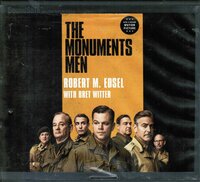Take a photo of a barcode or cover
611 reviews for:
The Monuments Men: Allied Heroes, Nazi Thieves, and the Greatest Treasure Hunt in History
Robert M. Edsel
611 reviews for:
The Monuments Men: Allied Heroes, Nazi Thieves, and the Greatest Treasure Hunt in History
Robert M. Edsel
Fascinating read. The flow was slightly odd but the book was still engrossing.
We do not want to destroy unnecessarily what men spent so much time and care and skill in making...{for} if these examples of craftsmanship tell us so much about our ancestors...If these things are lost or broken or destroyed, we lose a valuable part of our knowledge about our forefathers. No age lives entirely alone; every civilization is formed not merely by its own achievements but by what it has inherited from the past. If these things are destroyed, we have lost a part of our past, and we shall be the poorer for it.
This book is the first nonfiction book I've read about WWII that hasn't focused solely on the victims of genocide. In one light, this book seems insensitive because it takes the light off of the real victims of the war. On the other hand, it was enlightening to learn that the war was not just about human loss (although, of course it was) but it was also about the wholesale attempt to wipe out the entire existence and memory of cultures, which included all examples of written and artistic historical records.
It was interesting to learn about the tireless work of a very small team tasked with saving the world's greatest treasures. What drove these mostly middle-aged men to sign up for service straight into the dangerous front lines working often alone wasn't "just for duty. Success took conviction, a belief that the Monuments mission was not only right, but necessary. It couldn't be just a duty; it had to be a passion."
This book makes a good supplemental book to more comprehensive books about WWII. I think it suffered from trying to cover too much. It bounced from one art protector to another but the narrative seemed disjointed. Without having a thorough knowledge of the war and its major players, the reader would be lost reading this book. It covered the movement of the various Monuments Men in France and Germany in the last year of WWII. In the introduction, Edsel admitted to cutting out an entire section about the group's work in Italy.
This was the only WWII book I've read that didn't make me cry. I was uplifted by these hardworking players that were trying to mitigate the greatest theft in history and mitigate combat damage to and save more than 5 million stolen cultural objects. But the brief mentions of victims of the was missing heart. I watched the movie long before reading this book and although the movie was quite entertaining, the only thing about the movie that was true was that actual monuments men existed. Read the book to find out the actual story.
This book is the first nonfiction book I've read about WWII that hasn't focused solely on the victims of genocide. In one light, this book seems insensitive because it takes the light off of the real victims of the war. On the other hand, it was enlightening to learn that the war was not just about human loss (although, of course it was) but it was also about the wholesale attempt to wipe out the entire existence and memory of cultures, which included all examples of written and artistic historical records.
It was interesting to learn about the tireless work of a very small team tasked with saving the world's greatest treasures. What drove these mostly middle-aged men to sign up for service straight into the dangerous front lines working often alone wasn't "just for duty. Success took conviction, a belief that the Monuments mission was not only right, but necessary. It couldn't be just a duty; it had to be a passion."
This book makes a good supplemental book to more comprehensive books about WWII. I think it suffered from trying to cover too much. It bounced from one art protector to another but the narrative seemed disjointed. Without having a thorough knowledge of the war and its major players, the reader would be lost reading this book. It covered the movement of the various Monuments Men in France and Germany in the last year of WWII. In the introduction, Edsel admitted to cutting out an entire section about the group's work in Italy.
This was the only WWII book I've read that didn't make me cry. I was uplifted by these hardworking players that were trying to mitigate the greatest theft in history and mitigate combat damage to and save more than 5 million stolen cultural objects. But the brief mentions of victims of the was missing heart. I watched the movie long before reading this book and although the movie was quite entertaining, the only thing about the movie that was true was that actual monuments men existed. Read the book to find out the actual story.
I'd give this 3.5 if I could. The history captured here really speaks for itself, and this is a story that needed to be told since the Monuments Men's contributions go largely unspoken. It's fascinating to think of art's place in culture and the value placed upon some pieces but not others, especially when compared to human life.
But if you're going to read this, just know that the writing does get dull sometimes. I don't have a problem with dense writing, as that's something that comes with the non-fiction territory. However, Edsel jumps around a lot, which means he does a lot of repeating when he loops back around to his central figures. Stick with it, though. Some of the facts including in this book brought tears to my eyes.
But if you're going to read this, just know that the writing does get dull sometimes. I don't have a problem with dense writing, as that's something that comes with the non-fiction territory. However, Edsel jumps around a lot, which means he does a lot of repeating when he loops back around to his central figures. Stick with it, though. Some of the facts including in this book brought tears to my eyes.
Finished on the couch, pretty much binge read this in the last couple days.
Really interesting point of view of the war. The bureaucracy of it all was frustrating but clearly very real and for a non-fiction about war it was well written and easy to follow. The cuts to the nazi regime allowed you to remember the larger picture throughout.
Really interesting point of view of the war. The bureaucracy of it all was frustrating but clearly very real and for a non-fiction about war it was well written and easy to follow. The cuts to the nazi regime allowed you to remember the larger picture throughout.
I absolutely LOVED this book!! I really appreciate the style in which it was written. It was so descriptive that it almost felt like reading a novel. It's an incredible story of art and war. I enjoyed that the reader is given a glimpse into both sides of the conflict. One of the most interesting parts to me was the description of Hitler's vision for his art museum. I had no idea. I learned so much from reading this.
really interesting. I didn't realize how complex this was, finding, protecting, rescuing, and repairing art during WWII. Great reminder of the value of the arts. Sadly, reading in 2017, I heard too much history repeating itself - entitlement for the wealthy white, xenophobia, greed... Keep resisting.
Further proof that history is more exciting than the movies!
The story of the Monuments Men is a good one, but this author didn't tell it well. I was confused for most of the book and really struggled to finish it.
Never knew Hitler was obsessed with artwork to the point of looting precious gems from enemy countries during WW2.
This book about monuments men was long and at times repetitive. So many facts were thrown out that I felt I couldn't really make connections with the main characters. I will be watching the movie to really see the artwork the author described throughout this text. It's sad that right after WW2, the amazing works of these military men were for the most part lost from people's memory.
This book about monuments men was long and at times repetitive. So many facts were thrown out that I felt I couldn't really make connections with the main characters. I will be watching the movie to really see the artwork the author described throughout this text. It's sad that right after WW2, the amazing works of these military men were for the most part lost from people's memory.
So much better than the movie! An incredible story of salvaging the cultural history of Europe during WWII. Every art lover should read it.





